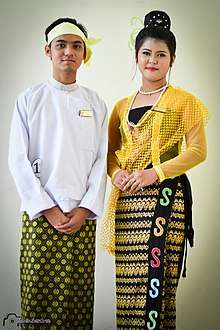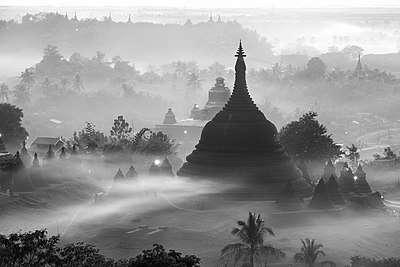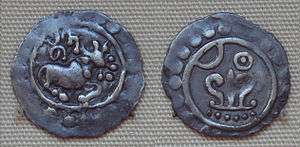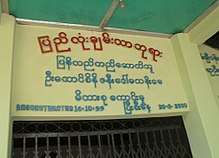Rakhine people
The Rakhine people or Arakanese people (Burmese: ရခိုင်လူမျိုး, Rakhine pronunciation: [ɹəkʰàiɰ̃ lùmjó], Burmese pronunciation: [jəkʰàiɰ̃ lùmjó]) are a Southeast Asian ethnic group in Myanmar (Burma) forming the majority along the coastal region of present-day Rakhine State (formerly officially called Arakan). They possibly constitute 5.53% or more of Myanmar's total population, but no accurate census figures exist. Rakhine people also live in the southeastern parts of Bangladesh, especially in Chittagong Division and Barisal Division. A group of Rakhine descendants, living in the Chittagong Hill Tracts of Bangladesh at least since the 16th century, are known as the Marma people or Mog people.
 Rakhine students in folk costume, 2018. | |
| Total population | |
| 3,361,000 (2010 est.) | |
| Regions with significant populations | |
| 3,300,000 | |
| 50,000 | |
| 2,500 | |
| Languages | |
| Arakanese, Burmese | |
| Religion | |
| Theravada Buddhism | |
| Related ethnic groups | |
| Sino-Tibetan peoples (inc. Bamar people, Marma people) | |
Arakanese descendants spread as far north as Tripura state in India, where their presence dates back to the ascent of the Arakanese kingdom when Tripura was ruled by Arakanese kings. In northeast India, these Arakanese people are referred to as the Mog, while in Indian history, the Marma (the ethnic Arakanese descendants in Bangladesh) and other Arakanese people are referred to as the Magh people.
Culture
The Rakhine are predominantly Theravada Buddhists and are one of the four main Buddhist ethnic groups of Burma (the others being the Bamar, Shan and Mon people). They claim to be one of the first groups to become followers of Gautama Buddha in Southeast Asia. The Rakhine culture is similar to the dominant Burmese culture but with more Indian influence, likely due to its geographical isolation from the Burmese mainland divided by the Arakan Mountains and its closer proximity to India. Traces of Indian influence remain in many aspects of Arakanese culture, including its literature, music, and cuisine. The traditional Rakhine Kyin wrestling also plays an important role in its culture. Rakhine mont di, a sort of traditional noodles, is popular across Myanmar.
Language
The Rakhine language is closely related to and generally mutually intelligible with Burmese. Rakhine notably retains an /r/ sound that has become /j/ in Burmese. The modern Rakhine script utilizes the Burmese alphabet. Formerly, the Rakhawunna script, found in stone inscriptions in the Vesali (Wethali) era, was used to write in Arakan.[1]
History
Dhanyawadi
Ancient Dhanyawadi (Pali: Dhaññavatī) lies west of the mountain ridge between the Kaladan and Le-mro rivers. Its city walls were made of brick, and form an irregular circle with a perimeter of about 9.6 kilometres (6.0 mi), enclosing an area of about 4.42 square kilometres (1.71 sq mi). Beyond the walls, the remains of a wide moat, now silted over and covered by paddy fields, are still visible in places. The remains of brick fortifications can be seen along the hilly ridge which provided protection from the west. Within the city, a similar wall and moat enclose the palace site, which has an area of 0.26 square kilometres (0.10 sq mi), and another wall surrounds the palace itself. Aerial photographs indicate that Dhanyawadi's irrigation channels and storage tanks were centred at the palace site.
| Macroperiod | Period | Start year | End year | Ruler | Notes |
|---|---|---|---|---|---|
| Dhanyawadi | The First Dhanyawadi | 3525 BC | 1489 BC | King Marayu | |
| The Second Dhanyawadi | 483 BC | 580 BC | King Kanrazagree | ||
| The Third Dhanyawadi | 580 BC | 326 AD | King Chandra Suriya | Great Image of Mahamuni was cast and probable first local appearance of Buddhism. Currency system by coinage is said to have been introduced in Rakhine economy. | |
| Vesali – Lemro | Vesali Kyauk Hlayga | 327 | 794 | King Dvan Chandra | |
| Sambawak | 794 | 818 | Prince Nga Tong Mong (Saw Shwe Lu) | ||
| Lemro | 818 | 1430 | King Nga Tone Mun | This period was the highest civilisation in the Bay and highly prosperous with busy international trade with the West. Pyinsa, Purain, Taung Ngu and Narinsara, Laungkrat cities flourished. Gold and silver coinage was used in trade relation in Rakhine in this period. | |
| Golden Mrauk-U | First Golden Mrauk-U | 1430 | 1530 | King Mun Saw Mwan (Min Saw Mon) | |
| Second Golden Mrauk-U | 1530 | 1638 | Solidified by King Mun Bun (Mun Ba Gri, Min Bin) | Rakhine reached at the zenith of the national unity and of the time of most powerful in the Bay in this period. | |
| Third Golden Mrauk-U Period | 1668 | 1784 | King Mahathamada Raza (Maha Thammada) |
Mrauk-U

Mrauk-U, the last kingdom of independent Arakan founded by King Mong Saw Mon in 1430, has become the principal seat of Buddhism, has reaching at zenith of the golden age. Mrauk-U was divided into three periods: the earliest period (1430–1530), the middle period (1531–1638), and the last period (1638–1784). In Arakan antiquities at the Mrauk-U seems to give rational evidence as to where Buddhism was settled down. The golden days of Mrauk U city, those of 16th and 17th centuries were contemporary to the days of Tudor kings, the Moghuls, the Ayutthaya kings and Ava (Inwa), Taungoo and Hanthawaddy kings of Myanmar. Mrauk U was cosmopolitan city, fortified by a 30-kilometer long fortification and an intricate net of moats and canals. At the centre of the city was the Royal Place, looming high over the surrounding area like an Asian Acropolis. Waterways formed by canals and creeks earned the fame of distinct resemblance to Venice.
Mrauk U offers some of the richest archaeological sites in Southeast Asia. These include stone inscriptions, Buddha images, the Buddha's footprints and the great pagoda itself which, stripped its later-constructed top, would be of the same design as the Gupta style of ancient India. In the city of golden Mrauk-U there are scattering innumerable temples and pagodas which preserved as places, thereby exerting a great influence on spiritual life of the people.
Historical artifacts

The oldest artefact, stone image of Fat Monk inscribed "Saccakaparibajaka Jina" in Brahmi script inscription comes to the date of first century AD.
An ancient stone inscription in Nagari character was discovered by the archaeologist Forchhammer. Known as Salagiri, this hill was where the great teacher came to Rakhine some 2500 years ago. Somewhere from eastern part of this hill, a stone image in Dhamma-cakra-mudra now kept in Mrauk-U museum, was found earlier in 1923. This relief sculpture found on the Salagiri Hill represents Bengali Hindu king Chandra Suriya belongs to 4th century CE; five more red sandstone slabs with the carving were found close by the south of this Salagiri Hill in 1986. They are the same type as the single slab found earlier in 1923. These carving slabs of Bhumispara-mudra, Kararuna-mudra, Dhammacakra-mudara, and Mmahaparinibbana-mudra represent the life of Buddha.
These sculptures provide earliest evident about the advent of Buddhism into Rakhine; during the lifetime of the Buddha and these discoveries were therefore assumed as the figures of King Chandra Suriya of Dyanawadi, who dedicated the Great Maha Muni Image. These archaeological findings have been studied by eminent scholars and conclusion is that the Maha Muni was made during the king Sanda Suriya era.
The founder of Vesali city, King Dvan Chandra carved Vesali Paragri Buddha-image in AD 327 and set a dedicatory inscription in Pali verse:
ye dhamma hetuppabhava / Tathagato aha / tesan ca yo nirodho / evamvadi Mahasamano.
That Buddha-image is carved out by a single block and the earliest image of Vesali.
The meaning of Ye Dhamma Hetu verse is as follow.
Of these dhammas which arise from causes / The Tathagata has declared causes / Lord Buddha preached about the causes / And the effects gained by the causes / And that which is the ceasing of them, Nirawda Thitesa / This the great ascetic declares.
The verse, which is considered as the essence of Theravada spirit, bears testimony to the fact that Buddhism flourished to an utmost degree in Vesali. The relationship of Vesali with foreign countries especially Ceylon would be established for Buddhism.
The stone inscriptions are of Sanskrit in Brahma script, Pali, Rakhine, Pyu languages. Anandachandra Inscriptions date back to 729 originally from Vesali now preserved at Shitethaung indicates adequate evidence for the earliest foundation of Buddhism. Dr. E. H. Johnston's analysis reveals a list of kings which he considered reliable beginning from Chandra dynasty. The western face inscription has 72 lines of text recorded in 51 verses describing the Anandachandra's ancestral rulers. Each face recorded the name and ruling period of each king who were believed to have ruled over the land before Anandachandra. Archaeology has shown that the establishment of so many stone pagodas and inscriptions which have been totally neglected for centuries in different part of Rakhine speak of popular favoured by Buddhism.
The cubic stone inscriptions record the peace making between the governor of Thandaway (Sandoway) Mong Khari (1433–1459, known in Burmese as Min Khayi) and Razadhiraj the Mon Emperor in Rakhine inscription. This was found from a garrison hill at the oldest site of Parein. A stone slab with the alleged figure of the Hindu Bengali King Chandra Suriya bore testimony to the Salagiri tradition, depicting of the advent of the Teacher to Dyanyawaddy.
Convention of the Buddhist Council in Rakhine
The crowning event in the history of Rakhine was the Convention of the Buddhist Council at the top of golden hill of Vesali under the royal patronage of King Dhammawizaya in AD 638 through joint effort of two countries, Rakhine and Ceylon. This momentous triumph of the great council was participated by one thousand monks from Ceylon and one thousand monks from Rakhine kingdom. As a fitting celebration of the occasion, the lavish construction of pagodas, statues and monasteries were undertaken for the purpose of inscribing the Tripitaka. After Vesali, Pyinsa was found by Lemro dynasty in 818; the great king of dynasty (818–1430) was King Mim-Yin-Phru, who turned his attention towards the development of Buddhism, and in 847 he convened the second Buddhist council in Rakhine attended by 800 Arahants. Rakhine chronicles report that therein the Tripitaka and Atthakatha were inscribed on the golden plate and enshrined. Never has there been impediment in the practice of Theravada Buddhist faith since it has been introduced in Rakhine. The copious findings of inscription Ye Dhamma verse were practical evidence that Theravada was dominant faith if epigraphic and archaeological sources were to be believed. The Royal patronage has always been significant factor contribution to stability and progress of the religion in Rakhine.
Architecture
Architecture resembles those from India, especially East India, due to civilizational influences. Arakanese chronicle records that more than six million shrines and pagodas flourished in Mrauk-U. In fact, they formed the pride of golden Mrauk-U. Dr. Forchhammer in his book entitled "Arakan", "in durability, architectural skill, and ornamentation the Mrauk-U temples far surpass those on the banks of Arrawaddy". Buddhist arts both in the field of architecture and Buddha-image constructions are on the same line of flourishing. An illustrative example of this fact can be seen in the temple of Chitthaung pagoda and colossal Dukekanthein temple. Gold and silver coins serve as the priceless heritage of the Mrauk-U period. The tradition of coin-making was handed down from the Vesali kings who started minting coins around the fifth century. The coins so far found are of one denomination only. Inscribed on the coins are the title of the ruling king and his year of coronation; coins before 1638 had Rakhine inscriptions on one side and Persian and Nagari inscriptions on the other. The inclusion of the foreign inscriptions was meant for the easy acceptance by the neighbouring countries and the Arab traders. Twenty-three types of silver coins and three types of gold coins have so far been found. All the kings who ascended the throne issued coins. City walls, gates, settlements, monastery sites, fortresses, garrisons and moats are the other priceless heritages left to the safe keeping of today's Rakhine people. Stone rubbles of proud mansions of that period are also priceless reminders of Rakhine glory.
It is no wonder that Mrauk U is properly known as the "Land of Pagodas" and Europeans remarked Mrauk U as "The Golden City". The Rakhine of those days were proud of Mrauk U. They were entirely satisfied to be the inhabitants of Mrauk U. The history shows what happened in the city in early times.
Foreign invasion
The country had been invaded several times, by the Mongols, Mon, Bamar and Portuguese and finally the Bamar in 1784 when the armies led by the Crown Prince, son of King Bodawpaya, of the Konbaung dynasty of Burma marched across the western Yoma (Arakan Mountains) and annexed Rakhine. The religious relics of the kingdom were stolen from Rakhine, most notably the Mahamuni Buddha image, and taken into central Burma where they remain today. The people of Rakhine resisted the conquest of the kingdom for decades after. Fighting with the Rakhine resistance, initially led by Nga Than Dè and finally by Chin Byan in border areas, created problems between British India and Burma. The year 1826 saw the defeat of the Bamar in the First Anglo-Burmese War and Rakhine was ceded to Britain under the Treaty of Yandabo. Sittwe (Akyab) was then designated the new capital of Rakhine. In 1852, Rakhine was merged into Lower Burma as a territorial division.
Independence movement
Rakhine was the centre of multiple insurgencies which fought against British rule, notably led by the monks U Ottama and U Seinda.
During the Second World War, Rakhine was given autonomy under the Japanese occupation of Burma and was even granted its own army known as the Arakan Defense Force. The Arakan Defense Force went over to the allies and turned against the Japanese in early 1945.
After Burmese independence
In 1948, Rakhine became a division within the Union of Burma. In 1974, the Ne Win government's new constitution granted Rakhine Division "state" status but the gesture was largely seen as meaningless since the military junta held all power in the country and in Rakhine. Present-day Rakhine are mainly living in Rakhine State, some parts of Ayeyarwady Division and Yangon Division of Burma. A small number of Rakhine live in the southern part of Bangladesh and India.
Bangladesh
There is a small community of Rakhine people inhabiting the coastal areas of Patuakhali, Borguna and Cox's Bazar, having migrated to Bangladesh from Myanmar before the formation of these two contemporary countries. The total population is 2,500.
History
The Rakhines landed in Cox's Bazar and Patuakhali District. The Konbaung Kingdom of Burma annexed Arakan in 1784 and refugees moved to Cox's Bazar in 1796. The British colonial officer of the East India Trading Company, Captain Hiram Cox, was given the task of providing land to the refugees in 1799. An estimated 100 thousand refugees were settled in Cox's Bazar, Chittagong Hill Tracts, and Patuakhali by the East India Company government.[2] They settled in Patuakhali District and Barguna District in the 19th century.[3]

The Rakhine people and the local Bengali population developed a unique dialect through which they could communicate. The Rakhine people were able to preserve their culture, language, and religion in Bengal. Rakhines observe Rakhine festival such as Sanggreng and Nai-chai ka.[2] The last Rakhine language school in Kuakata closed in 1998 due to shortage of funds, In January 2006, Chin Than Monjur, open Rakhine language community school which expanded into three news schools and used Rakhine language books from Myanmar. The schools were forced to close due to shortage of funds.[4]
Persecution
In Patuakhali District and Barguna District of Bangladesh, the Rakhine population declined from a high of about 100,000 in the 20th century to 2,500 in 2015. A number of the Rakhines have fled to Myanmar to escape Bengali persecution. There used to be 19 Buddhist temples, which has declined to just one by 2015.[3] The Rakhine cemetery in Taltali Upazila, Barguna District, was 150 years old. It was forcefully taken by local land grabbers. The Rakhine population in the district decreased by 95% and lands owned by Rakhines decreased by 83%.[5][6] Rakhine land is also being taken over by politicians in Patuakhali District.[7][8]
See also
References
- Vesali Coins in Sittwe and Mrauk-U Archaeological Museum; The Ananda Chandra inscriptions (729 A.D), at Shit Thaung Temple-Mrauk U; Some Sanskrit Inscriptions of Arakan, by E. H. Johnston; Pamela Gutman (2001) Burma's Lost Kingdoms: splendours of Arakan. Bangkok: Orchid Press; Ancient Arakan, by Pamela Gutman; Arakan Coins, by U San Tha Aung; The Buddhist Art of Ancient Arakan, by U San Tha Aung.
- Hasan, Kamrul. "Rakhain, The". en.banglapedia.org. Banglapedia. Retrieved 7 January 2018.
- "Thousands of Rakhine people left country". The Daily Star. 2 September 2015. Retrieved 7 January 2018.
- "Reopen the lone Rakhine language school in Kuakata". The Daily Star. 7 March 2011. Retrieved 7 January 2018.
- "Thousands of Rakhines left Bangladesh". The Daily Star. 30 March 2017. Retrieved 7 January 2018.
- "Market on Rakhine temple's land". The Daily Star. 27 October 2017. Retrieved 7 January 2018.
- "AL, BNP men's joint grabbing of Kuakata Rakhine land protested". The Daily Star. 15 July 2015. Retrieved 7 January 2018.
- "Give constitutional recognition to indigenous people". The Daily Star. 1 October 2010. Retrieved 7 January 2018.
Bibliography
- Charney, Michael W. (1999). 'Where Jambudipa and Islamdom Converged: Religious Change and the Emergence of Buddhist Communalism in Early Modern Arakan, 15th–19th Centuries.' PhD Dissertation, University of Michigan.
- Charney, Michael (2005). "Buddhism in Arakan:Theories and Historiography of the Religious Basis of Ethnonyms". "Arakan History Conference" [Bangkok]. Chulalongkorn University. Retrieved 10 July 2012.
- Leider, Jacques P. (2004). 'Le Royaume d'Arakan, Birmanie. Son histoire politique entre le début du XVe et la fin du XVIIe siècle,' Paris, EFEO.
- Loeffner, L. G. (1976). "Historical Phonology of Burmese and Arakanese Finals." Ninth International Conference on Sino-Tibetan Languages and Linguistics, Copenhagen. 22–24 Oct. 1976.